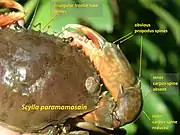Scylla paramamosain
Scylla paramamosain is a mud crab commonly consumed in Southeast Asia.
| Scylla paramamosain | |
|---|---|
 | |
| Green mud crab, Scylla paramamosain from Bekasi, West Java, Indonesia | |
| Scientific classification | |
| Kingdom: | |
| Phylum: | |
| Subphylum: | |
| Class: | |
| Order: | |
| Infraorder: | |
| Family: | |
| Genus: | |
| Species: | S. paramamosain |
| Binomial name | |
| Scylla paramamosain Estampador, 1949 | |
Distribution

Identification
Scylla paramamosain is found in Japan, South Korea, Taiwan, China (including Hong Kong), Vietnam, Cambodia, Singapore, Malaysia, and Indonesia.[1] It is now produced by aquaculture farms in southern Vietnam.[2]
Taxonomy
Scylla paramamosain was described by Eulogio P. Estampador in 1949, as a subspecies of Scylla serrata.[3][4] It is now known that the crabs previously referred to as S. serrata in China were mostly S. paramamosain.[5]
References
- "Scylla paramamosain Estampador, 1949". Crabs of Japan. Retrieved June 18, 2011.
- Stig M. Christensen; Donald J. Macintosh & Nguyen T. Phuong (2004). "Pond production of the mud crabs Scylla paramamosain (Estampador) and S. olivacea (Herbst) in the Mekong Delta, Vietnam, using two different supplementary diets". Aquaculture Research. 35 (11): 1013–1024. doi:10.1111/j.1365-2109.2004.01089.x.
- W. Stephenson & B. Campbell (1960). "The Australian Portunids (Crustacea: Portunidae). IV. Remaining Genera". Australian Journal of Marine and Freshwater Research. 11 (1): 73–122. doi:10.1071/MF9600073.
- Jesse D. Ronquillo; Zandro V. Pura & Rex M. Traifalgar. ""Seedling" production and pond culture of hatchery-produced juveniles of the mud crab Scylla oceanica Dana, 1852". In Frederick R. Schram & J. C. von Vaupel Klein (eds.). Crustaceans and the Biodiversity Crisis: Proceedings of the Fourth International Crustacean Congress, Amsterdam, the Netherlands, July 20-24, 1998 (PDF). Crustacean Issues. 12. Brill Publishers. pp. 999–1011. ISBN 978-90-04-11387-9.
- Ling-Bo Ma; Feng-Ying Zhang; Chun-Yan Ma & Zhen-Guo Qiao (2006). "Scylla paramamosain (Estampador) the most common mud crab (Genus Scylla) in China: evidence from mtDNA". Aquaculture Research. 37 (16): 1694–1698. doi:10.1111/j.1365-2109.2006.01603.x.
This article is issued from Wikipedia. The text is licensed under Creative Commons - Attribution - Sharealike. Additional terms may apply for the media files.